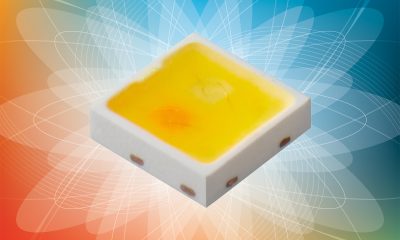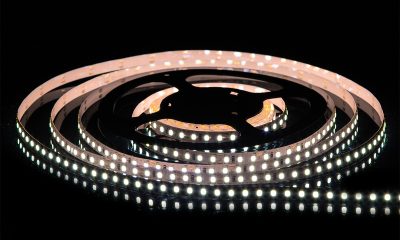What is a tunable white LED ceiling light
A tunable white LED ceiling light is a multi-channel LED system that allows the color temperature and intensity of the emitted light to be adjusted across a defined range. Color is an expression of light, which provides vision for the eye and thereby allows the human mind to create worlds of perception.
Tunable white lighting provides the technical ability to dynamically tune the light spectrum, making it a breeze to change the tint of white light between warm, neutral, and cool white. The color, or more precisely, the chromaticity of a light source is determined by the amount of energy at the various wavelengths in the visible portion of the electromagnetic spectrum. White light is a mixture of optical radiation in different colors. The ratio at which the colors are mixed determines the perceived warmth or coolness of white light, which is intuitively represented a color temperature. The concept of color temperature is based on based on the comparison of the chromaticity coordinate of a visible light source to that of an ideal black-body radiator. Correlated color temperature (CCT) is intended to characterize the apparent tint of white light emitted by light sources, e.g., LEDs and fluorescent lamps, whose chromaticity coordinates may not land exactly on the blackbody or the Planckian locus.
The essence of CCT tuning
Adjusting chromaticities of white light along the Planckian locus is a science of controlling the relative amount of short-wavelength energy (blue) to long-wavelength energy (red) in the spectrum of the light. Low-CCT light (around 2700K) is biased toward the long-wavelength part of the visible spectrum and is commonly referred to as having a warm white appearance. White light with a CCT between 3500K and 4100K has a relatively balanced blue/red spectral ratio and is thus considered “neutral white” in appearance. Light sources with a CCT around 5000K or more are biased toward the short-wavelength part of the visible spectrum and appear “cool” in appearance.
The perception of white light is how the human visual system discriminates between optical radiation at various wavelengths. The sensation of warmth and coolness influences people’s subjective interpretation of the environment. The direct relation between incident wavelengths and photoreceptor responses can influence human psychology and physiology. With the ability to provide an adjustable range of color temperatures, tunable white ceiling lights can be used to implement a holistic design of the visual, emotional and biological effects of light.
White light in different hues can initiate different biological processes
Different combinations of wavelengths that create white light not only affect visual perception with regard to aesthetics and artistic expression as well as subjective feelings such as comfort, pleasure and safety, they can also have profound implications beyond the perceptual effects. Human centric lighting (HCL) is the push behind the growing popularity of tunable white lighting products. HCL is a dynamic lighting solution that controls the spectrum and intensity of light to provide positive biological effects of light on human health, wellbeing and performance.
Light is the main environmental cue that resets and synchronizes the human biological clock. The suprachiasmatic nucleus (SCN) contained within the hypothalamus region of the brain is the body’s master biological clock which generates self-sustaining, endogenous oscillations having approximately 24-hour periods. The SCN drives and sustains rhythmicity in peripheral clocks throughout the body. These rhythms influence a wide range of physiological and behavioral systems that regulate sleep/wake cycle, hormone release, core body temperature, blood pressure, eating habits, digestion, and other important bodily functions.
Circadian rhythms in humans will run with a cycle period of slightly greater than 24 hours. To ensure that body’s physiological processes are in synchrony with the daily rhythms in its environment, the SCN must be entrained to the 24-hour environmental cycle through circadian phototransduction.
Circadian phototransduction
Circadian phototransduction is the process that photoreceptors in the retina transduce light into neural signals for the SCN. Although rods and cones participate in phototransduction, the main neural conduit to the SCN is formed by intrinsically photosensitive retinal ganglion cells (ipRGCs). The ipRGCs transmit information about overall environmental irradiance via the retino-hypothalamic tract (RHT) directly to the SCN, which in turn regulates body temperature and release hormones such as melatonin and cortisol.
Hormones, a class of signaling molecules in multicellular organisms, are an important component of the circadian system. The pineal gland secretion of melatonin corresponds with environmental signals of the SCN and defines biological night. Specifically, melatonin acts as the principal internal synchronizer of the peripheral clocks with the SCN. It travels in the bloodstream to provide circadian and seasonal information on the timing and photoperiods to the peripheral organs and tissues throughout the body. Aside from that, melatonin participates in direct modulation of cellular physiology as well as regulation of immunity to inhibit the development of tumor and cancers. It also plays an essential role in cardiovascular, reproductive system and neuropsychiatric health.
The human body is hardwired for natural daylight
During the process of evolution, the human circadian system became attuned to the 24-hour rhythm of the ambient changes in outdoor environments. Daylight varies over the course the day. Light information with regard to intensity, spectrum, timing, distribution and duration is captured by retinal photoreceptors and transduced to the SCN which then regulates the timing of various biological parameters. The human physiology is attuned to the progressive variation in light spectrum and intensity. As the day dawns, cortisol, dopamine and serotonin are secreted under the influence of blue-enriched daylight to program the body for daytime mode. As the sun sets in the west, the twilight contains more energy in the red part of the spectrum. The absence or low percentage of blue content supports the discharge of melatonin, thereby contributing to relaxation and regeneration.
In today’s world, however, people spend a significant portion of their day indoors. The lack of natural daylight exposes people to the risk of circadian disruption and subsequent health effects if the indoor environment fails to provide correct photic information for circadian entrainment. The loss of regular and appropriate-timed optical radiation input can cause impaired synchronization of the master clock to the local day-night cycle or impaired coupling between the master clock and peripheral oscillators. As a result, numerous negative consequences can occur. Adverse effects associated with circadian disruption could range from cardiovascular disorders, sleep disorders, impaired functioning of the immune system, neurological disorders, chronic fatigue, obesity and diabetes to impaired cognitive, psychological and social performance.
Mimic the quality and quantity of daylight to support circadian rhythms
Tunable white LED ceiling lights bring indoors the dynamics of daylight, allowing circadian rhythms to entrained to the external environment for a positive effect on human life. Traditional lighting products emit a static spectrum of light and thus are unable to mimic the changing wavelengths of daylight. The LED technology platform provides spectral tunability, which addresses the limitations of the previous lighting technologies and pushes the boundary of lighting functionality beyond basic illumination for vision and visibility.
LEDs can be tuned to emit colored light in a narrow spectral range through bandgap manipulation of quantum wells between the p-n junction of a semiconductor chip. They can also be engineered, through phosphor conversion within the device package, to produce full spectrum white light at any CCT. The availability of component LEDs in any color and the small footprint of these semiconductor devices combine to allow for design of multi-emitter color mixing systems with an additive mixture of colors at a close distance.
LEDs have superior controllability. Instantaneous, precise LED dimming over a full range of intensity allows to accurately control the mixing ratio for generation of any color or color temperature within the gamut. The semiconductor devices can be readily integrated with sensor, processors and control systems, which makes it possible to dynamically tune the intensity and the spectral power distribution (SPD) of the emitted light at a high level of automation.
Multi-channel LED mixing
The essence of tunable white lighting to split the color elements from a gamut into multiple channels that are individually addressed and controlled. LEDs of different channels are blended together in a way that the eye cannot discriminate the different wavelengths in white light at normal viewing distance. The light producing module of a tunable white LED ceiling light is designed as an assembly of discrete SMD LEDs or uses integrated LED packages/arrays. RGBA, RGBW or RGBWA LED systems can be used to create an infinite range of colors, including a full CCT range of high quality white light. However, these systems are costly and complex to implement.
Tunable white LED ceiling lights are generally CCT-mixing systems that use at least two channels of white LEDs. The most basic configuration of a tunable white LED module is a combination of warm-white and cool-white phosphor-converted (PC) LEDs. Their light is mixed in different proportions to achieve CCTs anywhere in between the minimum and maximum CCT. To simulate daylight as natural as possible, a wide tuning range, e.g., from 2700 to 6500 K, with the chromaticity coordinate shifting along the curve of the blackbody is a necessity. If only two primaries (CCTs) are used, the chromaticity coordinate curve is linear and thus deviates from the blackbody locus. To make the chromaticity coordinates land on the blackbody locus or, at least, nearby, one or more additional LED channels may need to be added to the gamut.
LED dimming and control
Tunable white lighting requires flexible and accurate control on each LED channel to provide the ability to change the color of light in a predictable appearance and allow for independent intensity adjustment. Each LED channel is dimmed individually through pulse-width modulation (PWM) and constant current reduction (CCR). CCR or analog dimming is simple to implement but achieving accurate, full range dimming with this method is technically challenging. The color point shifts when the drive current is changed over a wide range. Hence analog dimming is typically not used in applications where the color temperature and lumen output need to be precisely tuned.
PWM dimming can be digitally controlled to allow for 256 or more steps of color depth and will not cause color shift as the LEDs are always operated on the rated current during the dimming process. The dimming circuitry is controlled using various communication protocols such as 0-10V, DALI, DMX and ZigBee. The control channels are usually orchestrated by a microcontroller that runs color mixing algorithms. Connected lighting systems may employ cloud platforms to provide automated demand response and create sophisticated scenes.



















Loading...